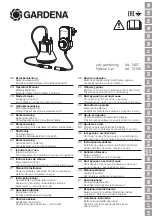
6
www.nieaf-smitt.com
4
Safety Measures
To ensure safe operation and service of the tester, follow these
instructions. Failure to observe warnings can result in severe
injury or death.
The testers have been constructed and tested in accordance with
the safety regulations for voltage testers and have left the factory
in a safe and perfect condition.
The operating instructions contain information and references
required for safe operation and use of the tester. Before using the
tester, read the operating instructions carefully and follow them
in all respects.
Depending on the internal impedance of the voltage detector
there will be a different capability of indicating the presence or
absence of operating voltage in case of the presence of interfe-
rence voltage.
A voltage detector of relatively low internal impedance,
compared to the reference value of 100 kΩ, will not indicate all
interference voltages having an original voltage value above the
ELV level. When in contact with the parts to be tested, the voltage
detector may discharge temporarily the interference voltage to a
level below the ELV, but it will be back to the original value when
the voltage detector is removed.
When the indication “voltage present” does not appear, it is hig-
hly recommended installing earthing equipment before work.
A voltage detector of relatively high internal impedance, com-
pared to the reference value of 100 kΩ, may not permit to clearly
indicate the absence of operating voltage in case of presence of
interference voltage.
When the indication “voltage present” appears on a part that
is expected to be disconnected of the installation, it is highly
recommended confirming by another means (e.g. use of an ade-
quate voltage detector, visual check of the disconnecting point
of the electric circuit, etc.) that there is no operating voltage on
the part to be tested and to conclude that the voltage indicated
by the voltage detector is an interference voltage.
A voltage detector declaring two values of internal impedance
has passed a performance test of managing interference voltages
and is (within technical limits) able to distinguish operating
voltage from interference voltage and has a means to directly or
indirectly indicate which type of voltage is present.
5
Danger of electric shock and other dangers
To avoid an electric shock, observe the precautions when wor-
king with voltages exceeding 120 VDC or 50 V eff AC. In accor-
dance with EN 61243-3 these values represent the threshold
contact voltages.
The tester must not be used with the battery compartment open.
Before using the tester, ensure that the test lead and device are
in perfect working order. Check for broken cables or leaking
batteries.
Hold the tester and accessories by the designated grip areas only,
the display elements must not be covered. Never touch the test
probes.
The tester may be used only within the specified measurement
ranges and in low-voltage installations up to 690 V. (EazyVolt Pro
LCD up to 1000 VAC and 1500 VDC)
The tester may be used only in the measuring circuit category it
has been designed for.
Before and after use, always check that the tester is in perfect
working order (e.g. on a known voltage source).
The tester must no longer be used if one or more functions fail or
if no functionality is indicated.
It is not permitted to use the tester during rain or precipitation.
A perfect display is guaranteed only within a temperature range
of -15 °C to +55 °C at an relative air humidity less than 85 %.
If the safety of the user cannot be guaranteed, the tester must be
switched off and secured against unintentional use.
Summary of Contents for EazyVolt Pro LED
Page 58: ...58 www nieaf smitt com ...







































